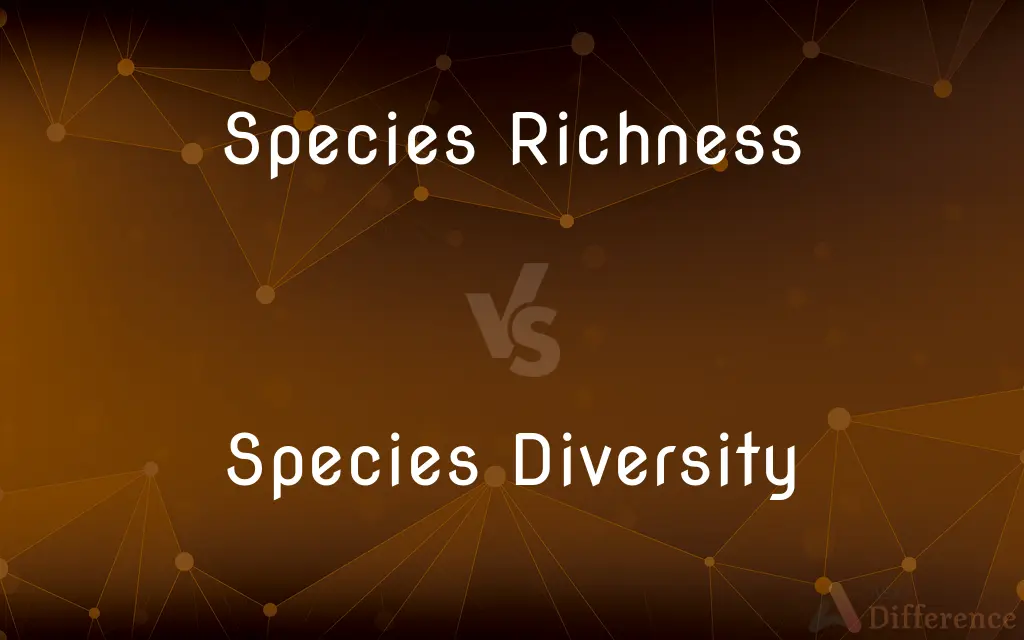Species Richness vs. Species Diversity — What's the Difference?
By Tayyaba Rehman — Published on November 23, 2023
Species Richness counts the number of species in a region. Species Diversity considers both the number and abundance of species. Both measure ecosystem health but in distinct ways.

Difference Between Species Richness and Species Diversity
Table of Contents
ADVERTISEMENT
Key Differences
Definition & Measurement: Species Richness is a simple count of the number of different species in a given area, ecosystem, or community. Species Diversity, however, is a broader concept that encompasses not only the number of species but also the relative abundance of each species present.
Purpose & Application: Researchers use Species Richness as a straightforward metric to understand the variety in a habitat. In contrast, Species Diversity provides a deeper insight into how species interact, the balance of populations, and potential dominance of certain species over others.
Ecosystem Implication: A high Species Richness can indicate a biodiverse area, but it doesn't always mean a balanced ecosystem. High Species Diversity indicates not just variety but also a more balanced and integrated ecosystem where no single species significantly overshadows others.
Practical Outcomes: An area with only high Species Richness can still be ecologically vulnerable if a few species dominate. But an area with high Species Diversity tends to be more resilient, as it suggests a healthy distribution of species populations, minimizing the impact of any one species' decline.
Relation & Dependency: While Species Richness is a component of Species Diversity, the latter provides a more comprehensive understanding of an ecosystem. An environment might have high Species Richness but low Species Diversity if one species predominates.
ADVERTISEMENT
Comparison Chart
Definition
Number of different species
Number + relative abundance of species
Reflects
Variety of species
Balance and integration of species
Ecosystem Implication
Indicates biodiversity
Indicates balanced biodiversity
Metric Complexity
Simpler metric
More comprehensive metric
Vulnerability
Can be vulnerable if dominated by few species
Tends to be resilient due to even distribution
Compare with Definitions
Species Richness
Gauge of an ecosystem's variety potential.
Marine biologists were amazed by the Species Richness found in deep-sea vents.
Species Diversity
A blend of species richness and evenness.
Rainforests not only have numerous species but also a good Species Diversity, indicating a balanced ecosystem.
Species Richness
Reflects biodiversity without accounting for abundance.
While two forests might have similar Species Richness, their species populations can differ greatly.
Species Diversity
Reflects species interactions and balance.
High Species Diversity in an area suggests minimal dominance by any single species.
Species Richness
Count of different species in a region.
The Amazon rainforest has a high Species Richness with thousands of unique plant species.
Species Diversity
Measure of both species number and abundance.
Coral reefs are often cited for their incredible Species Diversity.
Species Richness
A metric indicating the variety of species.
Islands isolated for millions of years often develop a unique Species Richness.
Species Diversity
Indicator of ecosystem health and balance.
Restored wetlands can take years to achieve the Species Diversity of undisturbed ones.
Species Richness
Solely number-based biodiversity measure.
Species Richness surveys are often the first step in conservation studies.
Species Diversity
Comprehensive metric of biodiversity.
Conservationists aim to maintain high Species Diversity to ensure ecosystem resilience.
Common Curiosities
Which metric considers the abundance of species?
Species Diversity.
Why is Species Diversity vital for ecosystem resilience?
Because it indicates a balanced and even distribution of species, reducing reliance on any one species.
Which metric only counts the number of species?
Species Richness.
Does high Species Diversity ensure a healthy ecosystem?
Generally, yes. It indicates a balanced and integrated distribution of species.
What's the main difference between the two metrics?
Species Richness counts species, while Species Diversity considers count and abundance.
Can an area have high Species Richness but low Species Diversity?
Yes, if one or few species dominate despite having many species present.
Are Species Richness and Species Diversity always correlated?
No, an area might have many species (richness) but be dominated by one (low diversity).
Can human activity influence Species Richness and Diversity?
Yes, habitat destruction, pollution, or introduction of invasive species can impact both.
Which is a simpler measure of biodiversity?
Species Richness.
How do conservationists use Species Richness data?
It's often a starting point for assessing biodiversity in conservation studies.
What's an example of a location with high Species Richness?
The Amazon rainforest.
Does Species Diversity imply more interactions between species?
Generally, yes. A balanced and diverse ecosystem often has intricate species interactions.
Why might two areas with similar Species Richness differ in Species Diversity?
Because one area might have a more even distribution of species populations than the other.
Which metric would give a deeper insight into an ecosystem's health?
Species Diversity, as it encompasses both variety and abundance of species.
Is Species Diversity a better metric for conservation planning?
It provides a more comprehensive understanding, so it's often preferred for conservation initiatives.
Share Your Discovery

Previous Comparison
Twin Bed vs. Double Bed
Next Comparison
Vitamin B3 vs. Vitamin B12Author Spotlight
Written by
Tayyaba RehmanTayyaba Rehman is a distinguished writer, currently serving as a primary contributor to askdifference.com. As a researcher in semantics and etymology, Tayyaba's passion for the complexity of languages and their distinctions has found a perfect home on the platform. Tayyaba delves into the intricacies of language, distinguishing between commonly confused words and phrases, thereby providing clarity for readers worldwide.












































